The Perseid is the most gifted Meteor Shower of the year for the Northern Hemisphere:
- The Perseid offers a consistently high rate of meteors every year (up to 100 meteors per hour)
- It occurs in August when the temperatures are usually nice enough for a night under the stars!
What is it?
Every year, the dust particles from the tail of the Swift-Tuttle comet pass the Earth orbit and burn in our atmosphere (about 70 miles / 110km above us) from mid-July to the end of August. The meteors (shooting stars) are in fact glowing columns of air resulting from the burn of these particles. When the dust and ice hits our atmosphere at around 37 miles / second (59km/s) they disintegrate high up in the atmosphere after making a brilliant flash of light. Most of these particles are the size of sand grains, while a few are as big as peas. They can streak across the sky in a flash, or persist for several seconds before vanishing. Meteor Showers peak, or reach maximum, at the same time each year.
Meteor Showers are named for the constellation out of which they seem to come. Because all of the particles are moving in roughly the same direction, the meteors which strike our atmosphere all “point” back to the direction of the comet’s path. This point in the sky is called the Meteor Shower Radiant. The Perseids appear to come from a point next to the constellation of Perseus. Perseids can be seen anywhere in the sky, but the direction of motion, when traced back, will point to a point next to the Perseus constellation.
Be Ready
Get prepared! While meteor shower observing requires no specific astronomical equipment, comfort is everything. Bring a long chair, a blanket, warm clothes and a bottle of water (or whatever you like to drink – a warm drink can help if it’s chilly outside). No use of binocular or telescope: they restrict your field of view. If you want to take pictures, take 5s to 15s exposures: longer exposures will make your piece of art blurry (don’t forget the stars are “moving” in the sky).
Pick a nice spot away from light pollution. Prefer isolated locations (beaches, mountains, parks, etc.). Try to avoid distraction like music, and don’t forget to switch off your cell phone!
Where to look?
The most important: try to turn away from the moon and any source of light pollution. The darker the skies are, the easier it will be to see meteors. You can watch pretty much every direction. Look about two-thirds away up to the sky to avoid light pollution over the horizon. It’s also the most confortable position if you’re in a long chair or lying on a blanket! During the best hour for observing the Perseids this year, you’ll have to look North/East to find the Perseus constellation. It may be easier to find Cassiopea first (the constellation that looks like a “W”): Persus is right next to it. Again, you don’t need to watch the Meteor Shower Radiant to see meteors; it’s just a good landmark for your observation session.
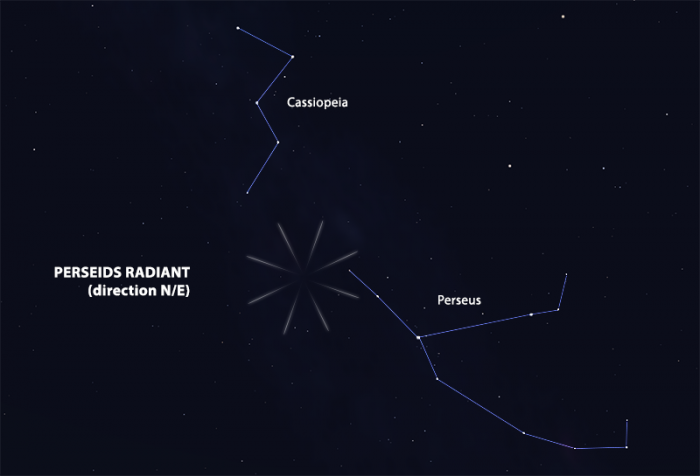
Perseids Radiant
When to look?
As Earth rotates, the side facing the direction of its orbit around the Sun tends to scoop up more space debris. This part of the sky is directly overhead at dawn. For this reason, the Perseids are usually best viewed in the predawn hours. 2013 is a great year to watch the Perseids, as the Moon will be out of the sky during key observation times (the moon will be only 34% full on peak day). This year, the first anticipated peak is on August 12th (13:00 UT), and the second peak is on August 13th (2:00 UT). The first peak is ideal for people living from Hawaii to the US West Coast. The second one will be more convenient for Europeans. If you live in the middle of the country or on the West Coast, you’ll have to get up early on August 12th but you won’t have dark skies for the peak.
| Peak at Local Time | Best Hours to watch | Sunrise | |
|---|---|---|---|
| Hawaii | August 12th, 3:00 AM HAST | August 12th, 3:00 AM HAST | August 12th, Sunrise: 6:09am |
| US West Coast (Los Angeles, CA) | August 12th, 6:00 AM PDT | Aug 12th 2/3 hours before sunrise | August 12th, Sunrise: 6:12am |
| US Center (Denver, CO) | August 12th, 7:00 AM MDT | Aug 12th 2/3 hours before sunrise | August 12th, Sunrise: 6:09am |
| US East Coast (Baltimore, MD) | August 12th, 9:00 AM EDT | Aug 12th 2/3 hours before sunrise | August 12th,Sunrise: 6:04am |
| Europe (München, DE) | August, 13th, 4:00 CEST | August, 13th, 4:00 CEST | August 13th, Sunrise: 6:11am |
| Middle East (Tel Aviv, IS) | August 13th, 5:00 IDT | August, 13th 2/3 hours before sunrise | August 13th, Sunrise: 6:03am |
Clear skies!
 American Meteor Society
American Meteor Society
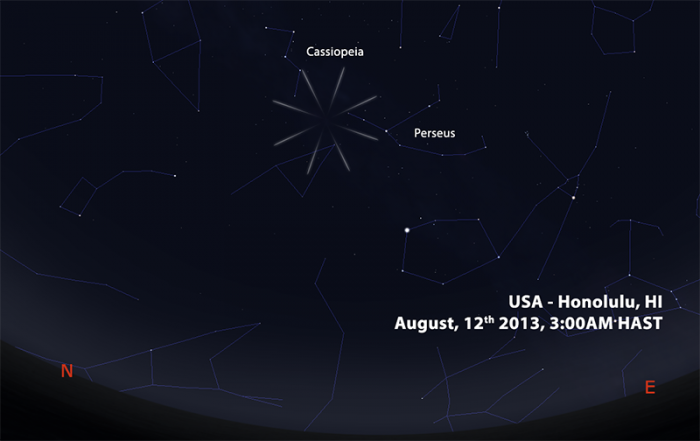
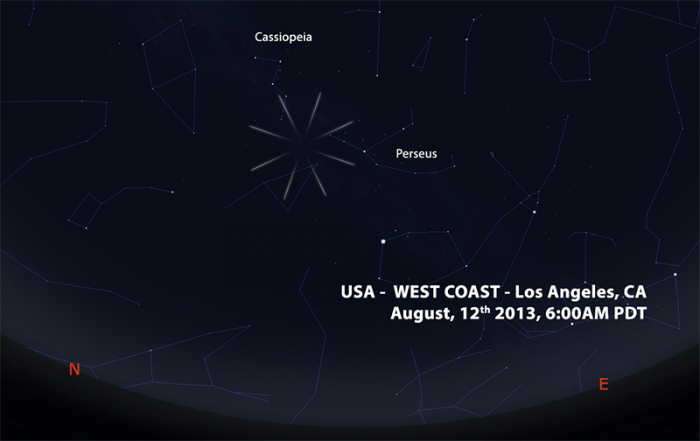
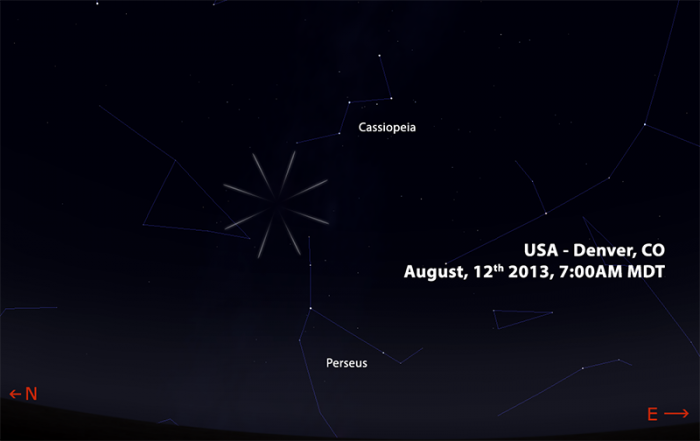
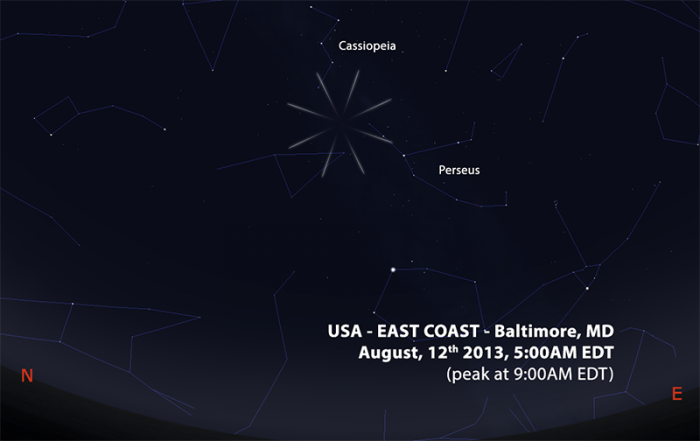
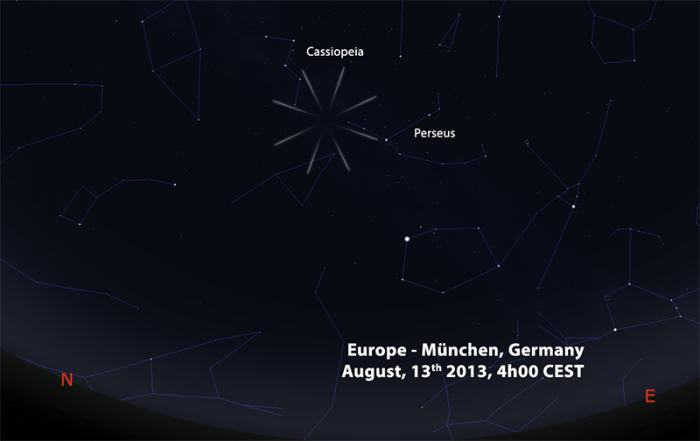
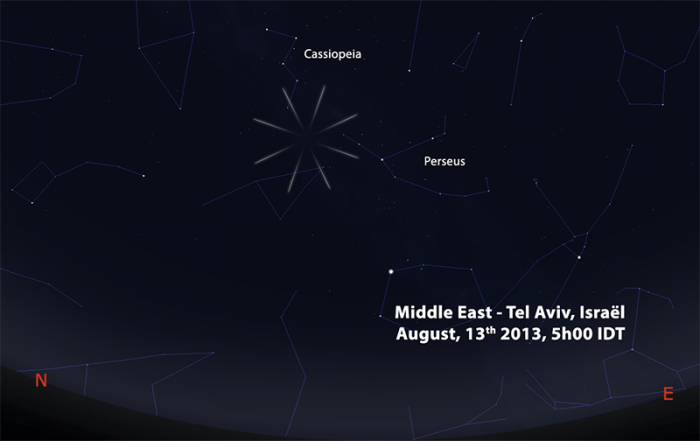
On the East coast, in CT, saw 3 nice ones in eastern sky. Two were going east, and the other from east – west in a more northeast sky. Looked like it had a double – tail? All between 3:33 am & 3:39 am.
I would like to know the day and time to watch the Perseid meteor shower from Qatar in Middle East
Yogini,
The 2nd Peak in Qatar is on August 13th 5:00am AST which is unfortunately the hour of the sunrise in your area. I would recommend you to start watching around 3/4am on August 13th.
Clear skies!
How is the center of the Milky Way galaxy positioned with reference to the Perseid shower radiant ?
Farrukh and All,
The center of the Milky Way lies in the constellation of Sagittarius the archer. As seen from mid-northern latitudes, Sagittarius lies low in the southern sky at dusk and sets in the SW near 3am local daylight time. The Perseid radiant lies almost opposite of Sagittarius as it lies low in the north at dusk and highest in the sky as the sun rises.
I hope this helps!
Robert Lunsford
I will be in Joshua Tree National Park in the night from Aug. 12 (evening) until Aug. 13 (morning). This is NOT the peak time mentioned. Can I still expect to see meteors?
Raul and All,
Although this will be one night after the peak, the activity still should be good with about 50 meteors being seen each hour between midnight and dawn. You can expect 30 of these meteors each hour to be Perseids.
Robert Lunsford
I am in the midwest United States and hoping to see the meteors tonight (August 12th) for my birthday! When is the best time to watch in my area, and will I be able to see them very well even though I live in the city and have a streetlight in my yard?
Jessica and All,
No matter where you live the best time to watch is between midnight and dawn. The streetlight will be a major nuisance as it, along with the thousands of other lights will obscure all but the brightest meteors. Try to look in the darkest direction to see the most activity.
Good Luck!
Robert Lunsford
saw two extremely bright ones kinda felt like i heard one
Some of the meteors are coming from a very different direction. Are they not part of the Perseids? What range of directions would you expect?
Random (sporadic) meteors occur every night of the year. They are not part of the Perseids and will travel in all directions at different velocities. There are also weak meteor showers present during the Perseids that will also produce meteors moving in different directions than the Perseids.
Robert Lunsford
It’s been cloudy the last few nights in Seattle. It’ll be clear tonight, after the peak. Will is still be worthwhile to check it out?
The Perseids will still be present for several more nights. This is also a good time to see random meteors and those from minor showers. Be certain to view AFTER the moon has set.
Robert Lunsford
“Perseids 2013: the Amateur Guide | American Meteor Society” genuinely got
me personally hooked with ur site! Iwill be back again far more regularly.
With thanks ,Lorrie